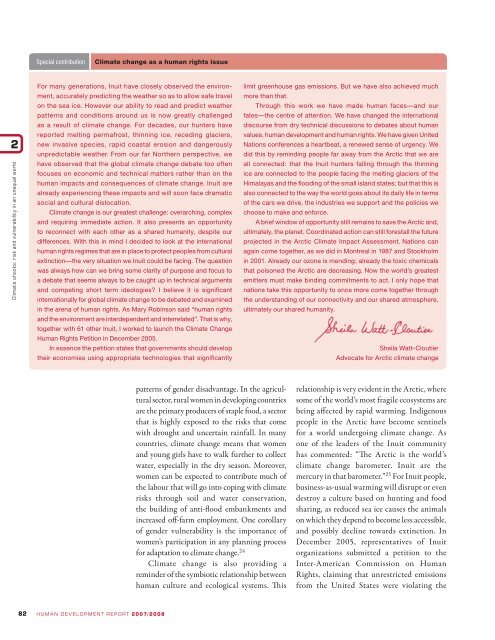The 21st Century climate challenge
The 21st Century climate challenge
The 21st Century climate challenge
You also want an ePaper? Increase the reach of your titles
YUMPU automatically turns print PDFs into web optimized ePapers that Google loves.
Special contributionClimate change as a human rights issue2Climate shocks: risk and vulnerability in an unequal worldFor many generations, Inuit have closely observed the environment,accurately predicting the weather so as to allow safe travelon the sea ice. However our ability to read and predict weatherpatterns and conditions around us is now greatly <strong>challenge</strong>das a result of <strong>climate</strong> change. For decades, our hunters havereported melting permafrost, thinning ice, receding glaciers,new invasive species, rapid coastal erosion and dangerouslyunpredictable weather. From our far Northern perspective, wehave observed that the global <strong>climate</strong> change debate too oftenfocuses on economic and technical matters rather than on thehuman impacts and consequences of <strong>climate</strong> change. Inuit arealready experiencing these impacts and will soon face dramaticsocial and cultural dislocation.Climate change is our greatest <strong>challenge</strong>: overarching, complexand requiring immediate action. It also presents an opportunityto reconnect with each other as a shared humanity, despite ourdifferences. With this in mind I decided to look at the internationalhuman rights regimes that are in place to protect peoples from culturalextinction—the very situation we Inuit could be facing. <strong>The</strong> questionwas always how can we bring some clarity of purpose and focus toa debate that seems always to be caught up in technical argumentsand competing short term ideologies? I believe it is signifi cantinternationally for global <strong>climate</strong> change to be debated and examinedin the arena of human rights. As Mary Robinson said “human rightsand the environment are interdependent and interrelated”. That is why,together with 61 other Inuit, I worked to launch the Climate ChangeHuman Rights Petition in December 2005.In essence the petition states that governments should developtheir economies using appropriate technologies that signifi cantlylimit greenhouse gas emissions. But we have also achieved muchmore than that.Through this work we have made human faces—and ourfates—the centre of attention. We have changed the internationaldiscourse from dry technical discussions to debates about humanvalues, human development and human rights. We have given UnitedNations conferences a heartbeat, a renewed sense of urgency. Wedid this by reminding people far away from the Arctic that we areall connected: that the Inuit hunters falling through the thinningice are connected to the people facing the melting glaciers of theHimalayas and the flooding of the small island states; but that this isalso connected to the way the world goes about its daily life in termsof the cars we drive, the industries we support and the policies wechoose to make and enforce.A brief window of opportunity still remains to save the Arctic and,ultimately, the planet. Coordinated action can still forestall the futureprojected in the Arctic Climate Impact Assessment. Nations canagain come together, as we did in Montreal in 1987 and Stockholmin 2001. Already our ozone is mending; already the toxic chemicalsthat poisoned the Arctic are decreasing. Now the world’s greatestemitters must make binding commitments to act. I only hope thatnations take this opportunity to once more come together throughthe understanding of our connectivity and our shared atmosphere,ultimately our shared humanity.Sheila Watt-CloutierAdvocate for Arctic <strong>climate</strong> changepatterns of gender disadvantage. In the agriculturalsector, rural women in developing countriesare the primary producers of staple food, a sectorthat is highly exposed to the risks that comewith drought and uncertain rainfall. In manycountries, <strong>climate</strong> change means that womenand young girls have to walk further to collectwater, especially in the dry season. Moreover,women can be expected to contribute much ofthe labour that will go into coping with <strong>climate</strong>risks through soil and water conservation,the building of anti-flood embankments andincreased off-farm employment. One corollaryof gender vulnerability is the importance ofwomen’s participation in any planning processfor adaptation to <strong>climate</strong> change. 24Climate change is also providing areminder of the symbiotic relationship betweenhuman culture and ecological systems. Thisrelationship is very evident in the Arctic, wheresome of the world’s most fragile ecosystems arebeing affected by rapid warming. Indigenouspeople in the Arctic have become sentinelsfor a world undergoing <strong>climate</strong> change. Asone of the leaders of the Inuit communityhas commented: “<strong>The</strong> Arctic is the world’s<strong>climate</strong> change barometer. Inuit are themercury in that barometer.” 25 For Inuit people,business-as-usual warming will disrupt or evendestroy a culture based on hunting and foodsharing, as reduced sea ice causes the animalson which they depend to become less accessible,and possibly decline towards extinction. InDecember 2005, representatives of Inuitorganizations submitted a petition to theInter-American Commission on HumanRights, claiming that unrestricted emissionsfrom the United States were violating the82 HUMAN DEVELOPMENT REPORT 2007/2008




